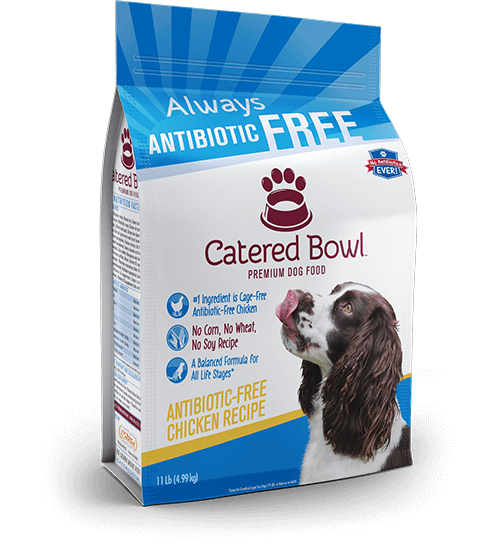
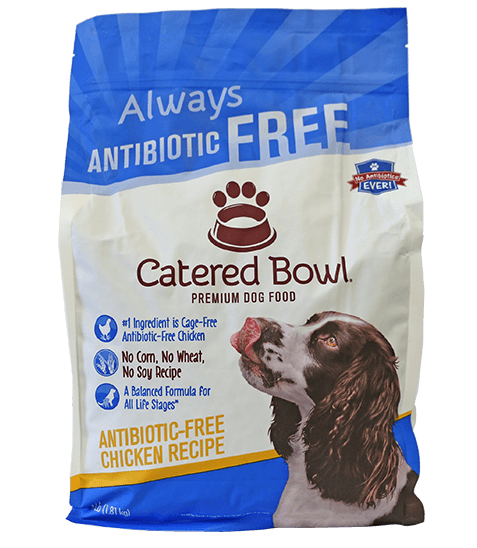
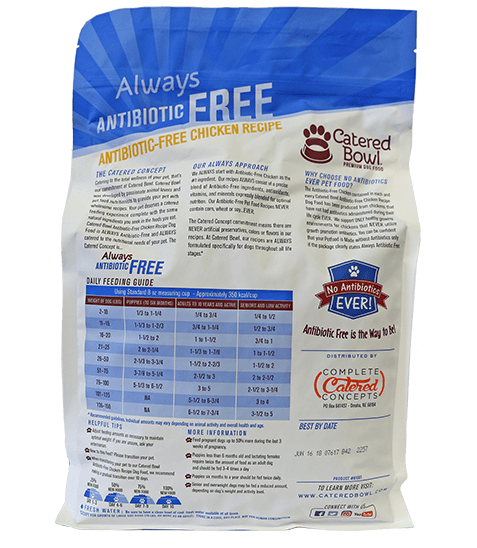
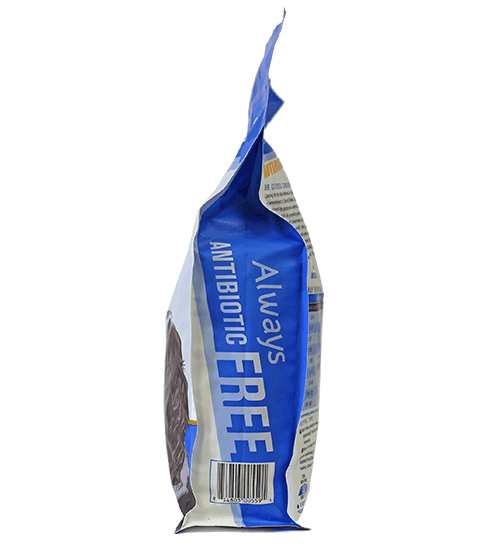
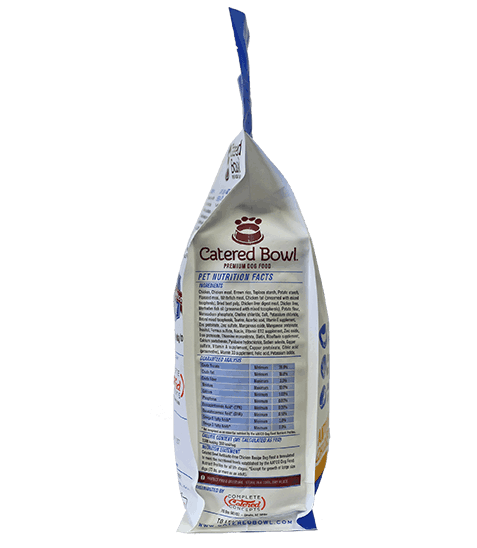
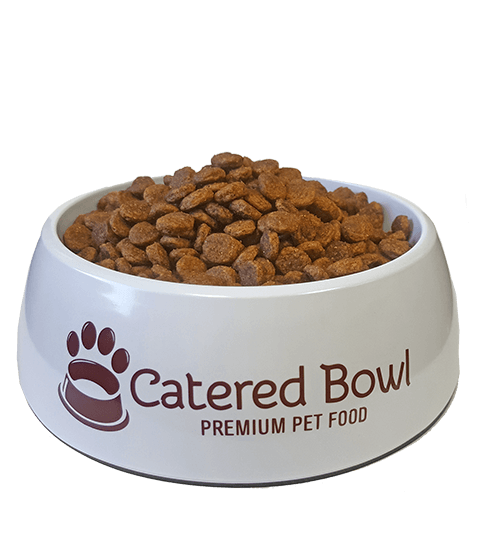
Antibiotic-Free Chicken Recipe
For all life stages#1 Ingredient: Cage-Free Chicken
We start with U.S. raised Cage-Free Antibiotic-Free Chicken as the #1 ingredient. Our recipes are made with a precise blend of natural ingredients, antioxidants, vitamins and minerals expressly blended for optimal nutrition.- Raised Cage-Free
- Antibiotic-Free
- All Life Stages
- Corn
- Wheat
- Soy
-
IngredientsChicken, Chicken meal, Brown rice, Tapioca starch, Potato starch, Flaxseed meal, Whitefish meal, Chicken fat (preserved with mixed tocopherols), Dried beet pulp, Chicken liver digest meal, Chicken liver, Menhaden fish oil (preserved with mixed tocopherols), Potato flour, Monosodium phosphate, Choline chloride, Salt, Potassium chloride, Natural mixed tocopherols, Taurine, Ascorbic acid, Vitamin E supplement, Zinc proteinate, Zinc sulfate, Manganous oxide, Manganese proteinate, Inositol, Ferrous sulfate, Niacin, Vitamin B12 supplement, Zinc oxide, Iron proteinate, Thiamine mononitrate, Biotin, Riboflavin supplement, Calcium pantothenate, Pyridoxine hydrochloride, Sodium selenite, Copper sulfate, Vitamin A supplement, Copper proteinate, Citric acid (preservative), Vitamin D3 supplement, Folic acid, Potassium iodide.
-
Guaranteed analysis
- Crude Protein 26% min
- Crude Fat 16% min
- Crude Fiber 3% max
- Moisture 10% max
- Calcium 1.05% min
- Phosphorus 0.85% min
- EPA (Eicosapentaenoic Acid) 0.20% min
- DHA (Docosahexaenoic Acid) 0.18% min
- Omega 6 Fatty Acids* 3% min
- Omega 3 Fatty Acids* 2% min
*Not recognized as an essential nutrient by the AAFCO Dog Food Nutrient Profiles.
Calorie Content (ME Calculated as Fed): 3,500 kcal/kg; 350 kcal/cupNutrition Statement
Catered Bowl Antibiotic-Free Chicken Recipe is formulated to meet the nutritional levels established by the AAFCO Dog Food Nutrient Profiles for all stages of life. Except growth of large size dogs, 70 lbs. or more as an adult. -
Feeding guide
- 2-10 lbs 1/3 to 1 1/4 cups
- 11-15 lbs 1 1/3 to 1 2/3 cups
- 16-20 lbs 1 1/2 to 2 cups
- 21-25 lbs 2 to 2 1/4 cups
- 26-50 lbs 2 1/3 to 3 3/4 cups
- 51-75 lbs 3 7/8 to 5 1/4 cups
- 76-100 lbs 5 1/3 to 6 1/2 cups
- 2-10 lbs 1/4 to 3/4 cup
- 11-15 lbs 3/4 to 1 1/4 cups
- 16-20 lbs 1 to 1 1/2 cups
- 21-25 lbs 1 1/3 to 1 7/8 cups
- 26-50 lbs 1 1/2 to 2 2/3 cups
- 51-75 lbs 2 1/2 to 3 cups
- 76-100 lbs 3 to 5 cups
- 101-125 lbs 5 1/2 to 6 3/4 cups
- 126-150 lbs 6 1/2 to 7 3/4 cups
- 2-10 lbs 1/4 to 1/2 cup
- 11-15 lbs 1/2 to 3/4 cup
- 16-20 lbs 3/4 to 1 cup
- 21-25 lbs 1 to 1 1/2 cups
- 26-50 lbs 1 1/2 to 2 cups
- 51-75 lbs 2 to 2 1/2 cups
- 76-100 lbs 2 1/2 to 3 1/4 cups
- 101-125 lbs 3 to 4 cups
- 126-150 lbs 3 1/2 to 5 cups
Puppies (up to 6 months)
^ Recommended guidelines. Individual amounts may vary depending on animal activity and overall health and age.
* Use standard 8 oz measuring cup; there are approximately 100 g (4 oz) per cup.Active Adult Dogs (up to 10 years)
^ Recommended guidelines. Individual amounts may vary depending on animal activity and overall health and age.
* Use standard 8 oz measuring cup; there are approximately 100 g (4 oz) per cup.Low-Activity Adult & Senior Dogs
^ Recommended guidelines. Individual amounts may vary depending on animal activity and overall health and age.
* Use standard 8 oz measuring cup; there are approximately 100 g (4 oz) per cup.MORE INFORMATION
Feed pregnant dogs up to 50% more during the last 3 weeks of pregnancy.Puppies less than 6 months old and lactating females require twice the amount of food as an adult dog and should be fed 3 to 4 times a day.
Puppies 6 months to a year should be fed twice daily.
Senior and overweight dogs may be fed a reduced amount, depending on dog’s weight and activity level.
Grain-free diets may not be suitable for all dogs. If you have any dietary concerns, please consult your veterinarian.
FRESH WATER: Be sure to have a clean bowl of cool, fresh water available at all times.
HELPFUL TIPS
Adjust feeding amounts as necessary to maintain optimal weight. If you are unsure, ask your veterinarian.New to this food? Please transition your pet.
When changing to Catered Bowl Antibiotic-Free Chicken Recipe Dog Food, some dogs may do better by making a gradual transition over 10 days. Start with 25% of the new food mixed with 75% of the previous diet, and gradually increase the new while decreasing the previous until the transition is complete.